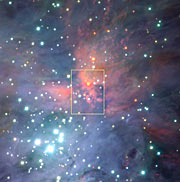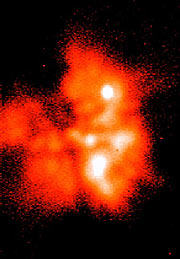Persbericht
TIMMI2 Images the Heart of the Orion Nebula
New Vistas with Powerful Thermal Infrared Instrument at La Silla
30 maart 2001
A new astronomical instrument, TIMMI2, has just been installed on the ESO 3.6-metre telescope at La Silla. The first images have just been obtained and hold great promise for future research programmes with this facility. The Thermal Infrared MultiMode Instrument was built in a collaboration between ESO and a consortium headed by the Jena University Observatory (Germany). It detects infrared radiation in the 5-24 µm mid-IR spectral region. It is particularly well suited for observations of the complex processes that take place in the innermost regions of star-forming clouds. It is also a forerunner of a similar, but even more powerful instrument to be installed at the 8.2-metre VLT telescopes on Paranal during the next years. Among the first images are some of the most penetrating, mid-infrared views ever obtained of the central region of the Orion Nebula.
Mid-infrared TIMMI2 images of a starforming region in Orion
A group of astronomers [1] has recently imaged a star-forming region in the Orion Nebula with a new and powerful astronomical instrument, the Thermal Infrared MultiMode Instrument (TIMMI2), now available at the La Silla Observatory. In addition to being scientifically very interesting, these observations also provide a demonstration of the impressive capabilities of this new facility.
It has been known for some time that the "BN/KL Complex" is a site of recent, massive star formation. It is located deep inside the Orion Nebula (ESO Press Photo eso0113a) and is observed as a cluster of infrared-emitting objects and compact regions of ionized Hydrogen ("H II regions"), associated with intricate interstellar dust filaments and circumstellar dust clouds. There are also several hot and large stars in this heavily obscured area - together they shine as bright as 100,000 suns.
It is a difficult task to identify the main sources of heating in this region - the "heart" of the Orion BN/KL star-forming complex . For this, a combination of sharp images (at 1 arcsec resolution or better) at different wavelengths is required. This is now possible with ISAAC near-infrared and TIMMI2 mid-infrared images that together show the energy distribution of the individual sources.
The present TIMMI2 images of the BN/KL Complex were obtained at two different wavelengths, 10.3 µm (ESO Press Photo eso0113b) and 20.0 µm (ESO Press Photo eso0113c).
These mid-infrared photos are powerful tools for the astronomers' attempts to analyze the very early processes of star formation. They mainly show the thermal radiation from the dust in the area that is heated by the UV and visible light from the stars, and especially the comparatively warm, dense dust cocoons around the very young stars. Contrarily, the slightly older stars in this area have already blown away most of their dust shell and can therefore be seen at shorter wavelengths, e.g. in the ISAAC image (ESO Press Photo eso0113a), but not in the TIMMI2 photos.
The dust clouds through which we can now look with TIMMI2 are extremely dense. The obscuration in the visual region of the spectrum is enormous, about 60 magnitudes (i.e., a factor of 10 24). No wonder that even the largest telescopes cannot get through to those "hidden" objects in visual light!
The ratio between the TIMMI2 images ("20µm/10µm"; ESO Press Photo eso0113d) provides a temperature map of the dust in this region. The "hottest" (brightest in this photo) areas mostly correspond to the cocoons around the very young stars. With the excellent image sharpness (about 1 arcsec) provided by TIMMI2, it was possible to identify ten new mid-infrared sources on this photo. From the image ratio, dust temperatures of up to about 190 °C (460K) are measured.
The TIMMI2 instrument
The new Thermal Infrared MultiMode Instrument (TIMMI2) (ESO Press Photo eso0113e) is a second-generation instrument for the ESO 3.6-m telescope on La Silla [2]. It is the most sensitive and most versatile instrument of its kind available in the world and puts European astronomy at the forefront of research in this field.
TIMMI2 is a combined camera and spectrometer that is able to register radiation ("light") in the mid-infrared spectral range from 5-24 µm. It is the successor to the most productive TIMMI instrument that was used at La Silla and decommissioned in 1998, cf. e.g., the reports about the first observations of structures in the disk around the star Beta Pictoris pointing to the presence of planets (article in Nature 369, p.628; 1994), the impact of Comet SL-9 on Jupiter and also about Comet Hale-Bopp.
To achieve sufficient sensitivity for thermal radiation from celestial objects, TIMMI2 must be cooled (as a normal camera for visible light must be black inside and light-tight). It operates at -230°C and the detector is kept at -260°C.
Mid-infrared astronomy is a very promising field
Quite apart from its own capabilities, TIMMI2 also represents an important step towards the VLT Mid Infrared Spectrometer/Imager VISIR, a similar, but even more advanced mid-infrared instrument for ESO's Very Large Telescope at Paranal. VISIR is now being constructed under ESO contract at research institutes in France and the Netherlands. It is planned to install it on the 8.2-m MELIPAL in 2002. The sensitivity will be five times higher than that of TIMMI2 and it will produce images that are twice as sharp. Until then, the ESO astronomers and engineers as well as many visiting astronomers will have gained invaluable experience with TIMMI2, ensuring them a fast and efficient entry into this largely unexplored field of astronomy.
Mid-infrared observations like these are a most valuable tool for studying the birth of stars and the formation of circumstellar disks and planets. As such it is complementary to submm observations, e.g. with the future ALMA facility.
Later, an extremely large telescope with similar instrumentation - like the 100-m OWL for which a concept study is now underway at ESO - may be used to image earth-size planets orbiting stars in our cosmic neighbourhood.
Noten
[1] The team consists of Rolf Chini and Markus Nielbock (Astronomisches Institut, Ruhr-Universität Bochum, Germany), Ralf Siebenmorgen and Hans-Ulrich Käufl (ESO-Garching, Germany).
[2] A more exhaustive description of TIMMI2 is available in the ESO Messenger (No. 102, page 4).
Contact
Ralf Siebenmorgen
ESO
Garching, Germany
Tel: +49-89-3200-6598
E-mail: rsiebenm@eso.org
Over dit bericht
| Persberichten nr.: | eso0113 |
| Legacy ID: | Photo 12a-e/01 |
| Naam: | Becklin/Neugebauer Complex, BN/KL Complex, M 42, Messier 42, Orion Nebula |
| Type: | Milky Way : Nebula : Type : Star Formation |
| Facility: | ESO 3.6-metre telescope, Very Large Telescope |
| Instruments: | ISAAC, TIMMI2 |





